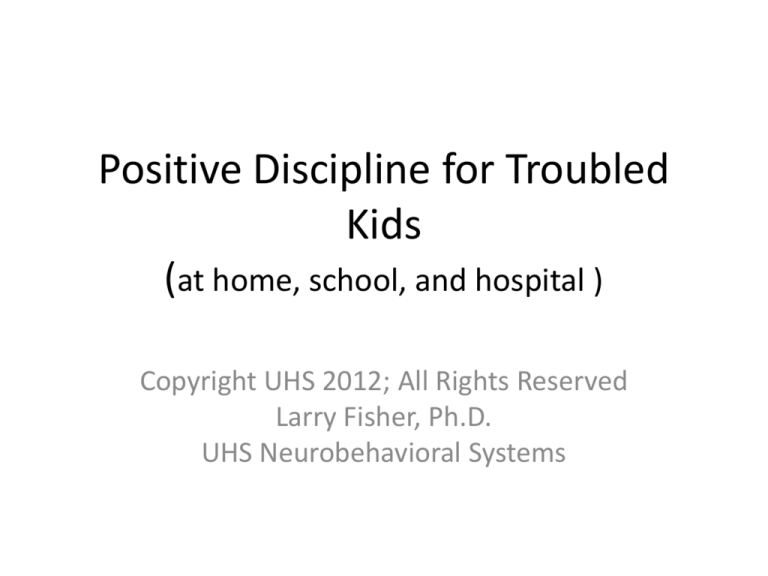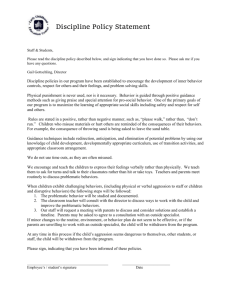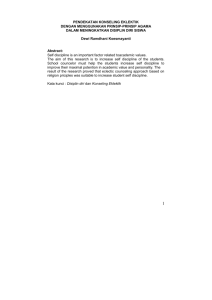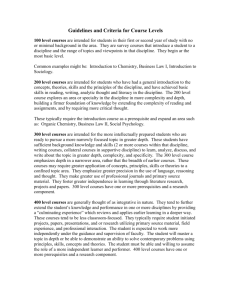
Positive Discipline for Troubled
Kids
(at home, school, and hospital )
Copyright UHS 2012; All Rights Reserved
Larry Fisher, Ph.D.
UHS Neurobehavioral Systems
Meridell Achievement Center
• Located on a 63-acre ranch in Liberty Hill
(northwest of Austin), Meridell is a 134 bed,
co-ed, neuropsychiatric hospital for troubled
children (5-11) and adolescents (12-17).
• The medical staff includes 5 Child and
Adolescent Psychiatrists, a Neuropsychiatrist,
a Pediatric Neurologist, a large number of
Nurses and Therapists, and a
Neuropsychologist.
What is Neuropsychiatry?
• Psychiatry & Neuropsychiatry both treat
maladaptive behavior.
• Neuropsychiatry is for maladaptive behavior
that is mostly impulsive, out of control, not
planned or for a purpose.
• It assumes there are brain issues & cognitive
deficits that require a somewhat different
approach.
A Brain Issue?
• Not a severe or progressive brain disease, just
a mild brain problem affecting two functions:
1) Frontal lobe - impulse control: child is
more impulsive, less able to inhibit behaviors.
2) Limbic system - emotion control: child is
more emotional, irritable, moody, and may
show impulsive aggression, or explosive
outbursts.
Isn’t Aggression Learned?
• There are two basic types of aggression, only
one of which is learned.
• Proactive Type (premeditated, planned, done
for a purpose, in-control, unemotional) which
is learned and may be due to poor parenting.
• Reactive Type (impulsive, irritable, short
temper, full of emotion, explosive, out-ofcontrol) which is not learned but due to brain
issues.
Parents Unjustly Blamed
• Neuropsychiatry program at Meridell is for those
children who show primarily reactive aggression
(too much emotion, too little control)
• This is not due to poor parenting, although most
doctors, therapists, teachers, neighbors, and
relatives may blame the parents.
• It is caused by a brain issue, not by parents, but
punitive parenting styles can make it worse.
What is different at Meridell?
• Assessment (of brain function)
– Neuropsychology tests and QEEG
• Medication (less sedating meds)
– Top down meds (to improve frontal lobe control)
– Bottom up meds ( to stabilize emotion brain)
• Therapy (more skill-based, cognitivebehavioral)
• Discipline (more use of Positive Discipline)
How is treatment different?
• There is less emphasis on treating the
diagnosis and more on assessing and treating
the brain issues.
• Emphasis is on building strengths rather than
dealing with weaknesses.
• Also, a greater emphasis on building resilience
and developing coping skills.
• Lastly, we use Positive Discipline.
What is Positive Discipline?
• The term “Discipline” is sometimes used to mean
strict punishments for misbehavior
– In fact, the term comes from 13th Century Old English
(e.g., The Canterbury Tales by Chaucer)
– “Discipline” means to teach, not to punish.
• Positive Discipline means use positives first
– For troubled kids, punishments create “escape”
behavior such as telling lies, or hiding misbehaviors
– Severe punishments may be counter productive
Positive Discipline; Step 1
• 1. USE POSITIVE DISCIPLINE FIRST
· Tell them what to do
· Not what to stop doing
· And use eye contact to increase chances of
compliance
• If they comply, praise, praise, praise
• If not, tell them again, and again, and again
Positive Discipline: Step 2
2. MILD/BRIEF CONSEQUENCES
• Only if positive discipline fails, after several
tries, do you use negative consequences
• However, only mild or brief negatives
• Do not try a “once and for all” negative
• Mild consequence is called “Response Cost”
• It costs something to be noncompliant
• Then redirect again: What to do next time
Why not get tough?
• Because it’s less effective with troubled teen
– Severe or prolonged punishments for troubled
kids can provoke depression, aggression, or
runaway.
• Think of what we do with toddlers…
– All toddlers misbehave…they have to learn
– We tell them what to do, and praise compliance
– If misbehaviors are frequent ,we use “time-out”
– “Time-Out” is mild, brief “response cost”
What About an Irritable Toddler?
• Most good parents know the difference:
– Misbehavior is a social learning issue
• Praise good behavior, use “time-out” for misbehavior
– Irritability is a mood that may cause misbehaviors
• Find cause and fix it; do not try to punish it away
• Example:
– Child repeatedly testing limits? Use “time-out”
– Child is irritable? Use checklist: is child hot?,
cold?, hungry?, thirsty?, wet?, dirty?, tired?, sick?
How About Troubled Teens?
• Teens are not toddlers. We expect more selfcontrol, more compliance. However….
• Troubled teens may be:
– Irritable, oppositional, defiant, depressed
– You can’t punish away irritability.
– But, you still can’t be permissive either
• The strategy is find the problem and fix it.
• In the meantime, use Positive Discipline.
What about tough love?
• Love is necessary; tough love not so much.
– Troubled teens are often irritable, impulsive,
moody
• Punishment does not improve irritability
• Punishment does not improve moodiness
• Punishment does not work for impulsive teens
– “Impulsive” means acting without thinking about
consequences (including prior punishments)
Bipolar
Spectrum
Anxiety
Disorders
TIC
disorders
OCD
Axis II –
Personality
disorders
Developmental
Disorders
AGGRESSION and
Antisocial
PTSD
IMPULSIVENESS
Substance
Use
Disorders
Autism
Spectrum
Schizophrenia
Spectrum
Disruptive
Behavior Disorders
Conduct
disorders
ADHD
Spectrum
ODD
Adapted from Connor, D. In: Aggression and Antisocial Behavior in Children and Adolescents:Research and Treatment. New York,, NY, Guilford Press, 2002
Use Positive Discipline First?
• YES! The first approach should be positive
– Tell them what to do, not what to stop doing
– If they comply, praise them (or use some reward)
– If they don’t comply, tell them again (no threats)
– Always get eye contact before giving directives
– Don’t scream, or threaten, just repeat directive
– Only if non-compliant after multiple attempts
• Then use a RESPONSE COST (e.g., mild punishment)
What is “Response Cost”?
• Any mild or brief negative consequence
– $1.00 reduction in their allowance
– Lock up their computer for one hour
– Ground them (to the house) for 2 hours
• “Response Cost” is not so severe at to produce
instant compliance; just to show displeasure
– Positives (e.g., praise, rewards) are the major tool
– Response Cost is just a backup tool
Positive Behavior Contracts
• Positive “Contracts” are to motivate child
• If Child does ‘A’, parent promises ‘B’
– Example: “When you take your meds, you can go
outside” , or, “When you finish your homework,
you can watch TV”
– Encourages negotiation, avoids power struggle.
Pairing wish-lists together.
– Win-Win arrangement, for oppositional kid
• You pair your wish-list with the kid’s wish-list
Grandma’s Rule for Contracts
• Can be written or oral (keep it simple)
– Written is better for forgetful kids
– Grandma’s rule: When you do what I want (“A”) you can
have or do what you want (“B”).
• Contracts are voluntary
– Child is not forced to comply (voluntary)
– But if he/she refuses ‘A’, then you refuse ‘B’
• Behavior comes first, then wish granted:
– Never allow a promise; only when child has done ‘A’ will
parent give, or allow, ‘B’
Where Does Positive Discipline Fit Into
Neuropsychiatry?
• Use positive first
– Tell ‘em what to do
– Not what to stop
• If positives fail– Mild, brief
– Response Cost
– Then redirect
• PRAISE compliance
• Reward compliance
• Law/order is good
– But punishment can’t
be your only tool
• Love needed too
– But it may not always
be enough
If all you have is a hammer:
Everything starts to look like a nail
• LAW AND ORDER?
– Necessary, but…
– It can’t be your only
tool
POSITIVE DISCIPLINE:
80% PRAISE
• 20% MILD CONSEQUENCES
• BEHAVIOR CONTRACTS
Pair your wish-list
with kid’s wish-list….
Grandma’s Rule:
When you do what I
want, I will allow or
do what you want.
Who Uses Positive Discipline?
• Parents
– Parent training
programs today use
mostly positives
• Schools
– More and more
schools are using
positive discipline
• Hospitals
– Psychiatric
– Neuropsychiatric
– Brain Injury Centers
– Pediatric Units
– Juvenile Justice Units
– Neurological Units
– State facilities
SUMMARY
• 21st Century Approach
– 21st Century Discipline for Troubled Teens is changing
• POSITIVE DISCIPLINE
– Not permissive; but also not highly punitive
– Use positives first; then, if needed, use “Response Cost”
• POSITIVE DISCIPLINE:
–
–
–
–
For troubled kids, getting tough doesn’t work
Love is necessary, but not sufficient:
Consider positive Behavior Contracts
In 21st Century: We Use Positive Discipline (home, school,
hospital)
Books
• Positive Discipline
– Jane Nelson
• Positive Discipline for Teenagers
– Jane Nelson & Lynn Lott
• Your Defiant Teen: 10 Steps to Resolving Conflict and Building
Relationships
– Russell Barkley
• Positive Parenting
– Glenn I. Latham
Books
Coccaro, E. F. (2003). Aggression: Psychiatric
Assessment and Treatment, Marcel Dekker,
New York.
Coffey, C.E. & Brumback, R.A., (2006). Pediatric
Neuropsychiatry, Lippincott Williams and
Wilkins, Philadelphia.
Connor, D.F. (2002). Aggression and Antisocial
Behavior in Children and Adolescents, The
Guildford Press, New York.
Books
Greene, R. W. (2010). The explosive child: A new
approach for understanding and parenting easily
frustrated, "chronically inflexible" children (Revised
4th edition). New York: HarperCollins.
Greene, R.W. (2008). Lost at School, Scribner, New
York.
Greenberg, R., (2007). Bipolar Kids: Helping Your Child
Find Calm in the Mood Storm. Da Capo
Press/Perseus Books Group, Cambridge, MA
References
Chen, T., Blum, K, Matthews, D., Fisher, L., et al. (2007).
Preliminary association of the TaqA1 allele of the Dopamine
D2 Receptor Gene and the Dopamine Transporter (DAT1) 480
bp Allele with pathological violent behavior in adolescents.
Gene Ther. Mol. Bio., Vol. 11, 93-112.
Fisher, W., Matthews, D., Fisher, L., Williams, A., and Klein, H.
(2010). Gender and memory as significant predictors of
electrical abnormality in impulsively aggressive juveniles.
Poster presentation at the American Neuropsychiatric
Association, Mar. 19, Tampa, Fl.
References
Epstein, T., & Saltzman-Benaiah, J. (2010). Parenting children
with disruptive behaviors: Evaluation of a Collaborative
Problem Solving pilot program. Journal of Clinical Psychology
Practice, 27-40.
Fisher, W., Ceballos, N., Matthews, D., & Fisher, L. (2011). Eventrelated Potentials in Juveniles with Impulsive Aggression, a
Chart-Review Study. Psychiatry Research, 187, 3, 409-413.
Fisher, W., Matthews, D., Fisher, L., and Ceballos, N., (2008).
Neurophysiological Correlates of Impulsive Aggression. Poster
presentation at the International Society for Research on
Aggression, Budapest, Hungary.
References
Fisher, W., Kroll, G., Matthews, D., and Fisher, L. (2007). Youth
with Impulsive Aggression: Anticonvulsant Compliance and
Outcome for 2005-2006. Abstracts of the Poster at the
American Neuropsychiatric Association, Tucson, AZ, J.
Neuropsychiatry Clin Neurosci 19: 208.
Fisher, L. & Matthews, D. (2004). Anticonvulsant Medication for
Impulsive Aggression: An Outcome Study. Abstract of the
Poster at the American Neuropsychiatric Association, Bal
Harbour, FL, J. Neuropsychiatry Clin Neurosci, 16: 215-217.
References
Matthews, D., Fisher, W., Ceballos, N., and Fisher, L. (2009).
Event Related Potentials in Juveniles with Impulsive
Aggression. Abstract of the Poster at the American
Neuropsychiatric Association, San Antonio, TX, J
Neuropsychiatry Clin Neurosci, 21:2, 221.
Wetherill, R., Kroll, G., Fisher, L., and Matthews, D. (2006). Youth
with Impulsive Aggression: Anticonvulsant Medication
Compliance and Outcome. Abstract of the Poster at the
American Neuropsychiatric Association, La Jolla, CA, J.
Neuropsychiatry Clin Neurosci 18: 252-255.
Links
• T-MAY Maladaptive Aggression in Youth
– www.thereachinstitute.org/t-may-static.html
• Positive Discipline
– www.positivediscipline.com
• Universal Health Services
– www.uhsinc.com
• Collaborative Problem Solving
– www.livesinthebalance.org










